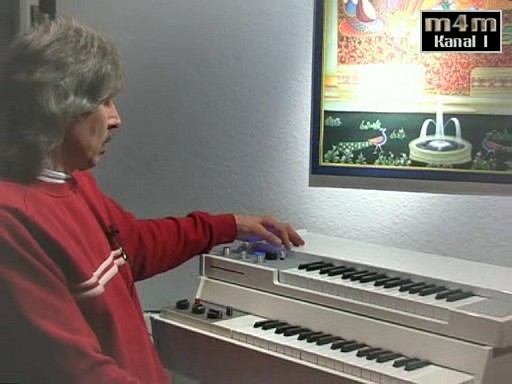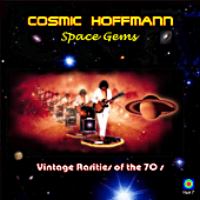|

Klaus, please tell us about your musical roots. When did you more focus on electronic music?
I started playing the guitar in 1966 at the age of 15. My first band and the first gig happened in 1967. But it took another two years to become more perfect and to really gig with my own band Archaeopteryx which became Impuls in 1971. Through the early 70s we were playing a lot of gigs with Nektar, Edgar Broughton Band, Hoelderlin, Broeselmaschine, Kin Pin Meh, Eloy and a bunch of other well-known bands. In 1972 I became interested in electronic music but with the purchase of a minimoog and a white mellotron in 1975 my interest in making and recording electronic music myself became evident.
In 1977 I got an offer (while recording as a guitarist and keyboarder with the known Alma Ata prog-rock band the second lp “Dreams”) from Cain Records to record my own lp (after they had just published Jürgen Pluta’s first lp). But my dear band “colleagues” spoiled my deal with the company, telling them a lot of nonsense that I would be too involved in gigging with the Almas , and so they tried to force me to stay with them! Some of those songs for the projected first lp were quite recently released as Cosmic Hoffmann’s “Space Gems”.
Somewhere in the 70s you started your project Cosmic Hoffmann. When and how did that happen?
I had been jamming electronically a lot with my friends and guests in the living community in the time between 1973 and 1978. Having built my studio from a two-track Akai tape recorder, an echo device and a simple mixing desk up to a sophisticated quadraphonic sound system with a Teac four track, several echo machines, a Moog, a Mellotron and the Roland 100 Modular System, the time seemed ripe for a gig (with a wild drummer and another synth player) in a youth centre of my hometown Duisburg. Lacking a name for the jam band the people of the youth centre gave us the funny name Cosmic Hoffmann, billing us as ‘The Close Encounter of the Fourth Kind’! And it really was one – until the police stopped the rather spacey two-hours-show around midnight!
What made you put that project on hold? Was it the new project Mind over Matter?
Cosmic Hoffmann never really existed as a band then, more as a loose coming together of people interested in sequences, space music and mind-expanding sonic journeys (which it still is). In the 80s this project became more and more a melting-pot for my own synthesizer influenced ideas.
 In 1981 I signed a contract with EMI for a single with the dull name “Weltraumboogie”. It was the time of simple synth melodies with danceable rhythms, and my song had it all. I never quite understood why those record company blokes raved so enormously about a song that was pure fun, not to be taken seriously! But they probably scented a big hit in it (which it never became) and gave me a lot of money. Quite an experience but not my path to follow in the future! In 1981 I signed a contract with EMI for a single with the dull name “Weltraumboogie”. It was the time of simple synth melodies with danceable rhythms, and my song had it all. I never quite understood why those record company blokes raved so enormously about a song that was pure fun, not to be taken seriously! But they probably scented a big hit in it (which it never became) and gave me a lot of money. Quite an experience but not my path to follow in the future!
After I started to explore South-East Asia in the early 80s my musical interests changed. Still I appreciated electronic sounds but I got to know other cultures and their music impressed me a lot deeper.
What is the project Mind over Matter (MOM) all about? Did you have any initial concept for it in mind?
The idea and foundation for Mind Over Matter was laid after I had come back (severely ill with a hepatitis A) from my first journey to India in 1982, my mind being filled with impressions, pictures and sounds that slowly formed the Mind Over Matter music. As I needed rest then I longed for quieter sounds with good melodies and atmospheres, the complete opposite of the then popular harsh electronic beats and dance floor noises. As I always had liked the beautiful music of Peter Michael Hamel, especially his great “Dharana” album where he combined his Asian-influenced band Between with a very subtly playing Balinese Gamelan orchestra, I wanted to create something of the same mood with a spiritual feel and warmth in it. After a period of several years my “Paradise”’ song was finally completed, fully reflecting my feelings and thoughts of those years between 1982 and 1985.
It was Andreas Hub, a friend writing stories for musical papers and hosting radio shows (like Winfrid Trenkler) for the WDR radio station, who encouraged me to record enough material for my first album. At that time my studio was professionally equipped with a Tascam 16-track recorder and a lot of high class effect devices enabling me to produce my music in cd quality which finally impressed the guys at the IC record company in 1985 to offer me a contract.

Mind Over Matter live at the 1st Kölner Synthesizer Multimedia Festival, 1991
The various albums of MOM have all been released on Innovative Communications(IC).How did you get contracted, how do you look back on that period?
Again it was Andreas who paved my path to IC. He also helped me a lot with his radio and paper work to have a good start with my new Mind Over Matter project. I felt that this was the chance of my life to finally bring out my own music!
So long had I delivered complete songs and concepts to the previous bands I had been in and so often could I hardly recognize my ideas when they had gone through the ‘band processing’ that often only left fragments of my melodies and song structures.
But now I wanted to have the complete control over the whole recording process ensuring that no more tracks were changed, deleted or forgotten (yes, those things happened quite often). Every note should be played in a way that fully added to the whole song, creating an emotional atmosphere with a lot of tiny sonic details for the listeners to discover and a sound that would be able to carry people mentally away to different places and moods. And believe me – I worked and suffered a lot to reach my ambitious musical goals!
In my first IC years (1985 – 1995) the company treated me quite fair and gave me a good support, unfortunately not the massive support they usually granted their personal projects Software and Quiet Force, but they made my music and my name world-wide known. However, when IC was sold to DA Music in 2000 I was quite happy to stand on my own feet again, just having started my own Heart & Mind label where I am the only person responsible for the whole creative process.
Presently my relation to the new IC owner, that still keep the rights for my back catalogue, is at its best, leaving me full artistic freedom and respecting my decisions. They offered me the chance to publish my personal pictures from various journeys to Asia (along with a sort of MOM’s ‘Best of’) on two dvd’s. Their actual “Indian Meditation” series with remixes of my music from the first nine IC albums has become a hit for them too with more than 10.000 copies sold.
 Klaus, can you provide a more in-depth description of each Mind over Matter albums that have been released? Klaus, can you provide a more in-depth description of each Mind over Matter albums that have been released?
When “Music for Paradise” came out I did not have the slightest idea that it would be the promising start of a line of lp/cds. Expecting only sales of let’s say some hundred copies, I found myself very soon in the radio’s annual charts on the highest ranks. “Music for Paradise” being an instant success, the stress began with the second (then cd) “The Colours of Life”!
 Within only one year I had to create a follow-up record that should become a winner too without simply copying the first one. Oh boy, what a difficult task! At the end of the day I decided to use the impressions (the birth of my son Tim) I was under then as a platform for my new songs and it perfectly worked. Songs like “Bali Sunrise” and “Ganga” have become MOM trademarks and helped to sell the album more than 16.000 times. Within only one year I had to create a follow-up record that should become a winner too without simply copying the first one. Oh boy, what a difficult task! At the end of the day I decided to use the impressions (the birth of my son Tim) I was under then as a platform for my new songs and it perfectly worked. Songs like “Bali Sunrise” and “Ganga” have become MOM trademarks and helped to sell the album more than 16.000 times.
When the third album was due, the decision which way to follow became even more complicated: should it be like the first or the second album or should it be something completely different?
Remembering my progressive rock background, “Trance ‘n’ Dance” became rather impressive and powerful with songs like “Children of the Midnight” and the MOM hymn “Jack the Bear” (a song about two heavy Canadian drug-takers I met in Thailand). The newly assembled MOM live-band helped to put this music on stage and soon Mind Over Matter became known for its spectacular shows with masks, dancers and fireworks (resulting in the “Live in Concert” album).
In 1992 “In Search of Eternity”  with its exceeding “Journey to Eternity”’ and “‘Pilgrims of Eternity” came out, reflecting the Buddhist influence I was under at that time. “Palace of the Winds” followed in 1995 and won a lot of international prizes. Especially its tremendous “Shangri-La” deeply impressed the critics and the listeners. The corresponding stage shows with sabre dances, flags and a belly dancer helped to make MOM even more known. with its exceeding “Journey to Eternity”’ and “‘Pilgrims of Eternity” came out, reflecting the Buddhist influence I was under at that time. “Palace of the Winds” followed in 1995 and won a lot of international prizes. Especially its tremendous “Shangri-La” deeply impressed the critics and the listeners. The corresponding stage shows with sabre dances, flags and a belly dancer helped to make MOM even more known.
I felt at that time that it was time for something quiet again and produced “Shambala”, a blend of new and some completely remixed older songs, intended to work as a perfect background for meditative situations.
 With “Avatar” in 1997, a mixture of one of my best prog-rock pieces (“Thunderchild”) and a more electronically influenced “Avatar” main piece took place. But I soon had to find out that not all of my listeners could cope with this more electronic way I had pursued with Stephen Parsick then. With “Avatar” in 1997, a mixture of one of my best prog-rock pieces (“Thunderchild”) and a more electronically influenced “Avatar” main piece took place. But I soon had to find out that not all of my listeners could cope with this more electronic way I had pursued with Stephen Parsick then.
I learnt that it was time to divide my two veins, the electronic and the Asian vein, into two separate projects which conclusively led to the Cosmic Hoffmann project. “Under the Stars”, a compilation of MOM’s best live work in planetariums, came out in 2000 when the decay of IC was obvious.
 Starting again with the new owner, IC published two dvd’s (“Asia Vol.1” and “Asia Vol.2”) with sonically improved versions (Dolby 5.1) of my best songs along with footage from my travelling and a rare live video of the MOM Live-band. Starting again with the new owner, IC published two dvd’s (“Asia Vol.1” and “Asia Vol.2”) with sonically improved versions (Dolby 5.1) of my best songs along with footage from my travelling and a rare live video of the MOM Live-band.
With “On the Wings of the Wind”, the first MOM-cd on my own label, varying floating songs for travelling in a gas balloon came out in 2004 that many listeners appreciate as one of my most atmospheric works.
During the IC-period you also collaborated with other musicians like e.g. Patrick Kosmos, Peter Mergener, Ron Boots, Thomas Fanger, Pyramid Peak and Stephen Parsick. How did these collaborations take place?
Whenever I meet interesting musicians where the chemistry is right I like to make recordings with them that either are released on my or on their records.
At times I added some Mellotron or guitar work to their existing songs or the songs emerged while we were playing together.
How does your studio look like, what instruments and additional gear do you use?
Compared with the big studio I used to work in during the 80s and 90s, the digitalization has made smaller studio with a lot more technical variety possible. Nowadays, in my smaller studio, I use a fully automated 16 track Yamaha workstation with total recall facilities for all kinds of volume, effect or EQ settings in combination with a pc for the mastering. Several effect processors along with two drum modules provide a lot of excellent sounds.
My main instrument (next to the guitar) is a fully equipped Kurzweil 2500 S. An Alesis Andromeda A6 poly synth with its 32 oscillators takes care of the analogue sounds whereas the Roland JD 800 is the ultimate space pad machine.
My guitars: 1966 Gibson ES 335, 1972 Gibson J 200 Jumbo acoustic guitar, a Jerry Jones Electric Sitar, an electric Rickenbacker 12-string, a Lakewood 12-string, a custom-made NAFI Electric Calabash Sitar along with a bunch of effect pedals and a Hughes & Kettner Stereo Guitar amp.
You’re also the inventor of the “Megatron”, often described as the ultimate digital Mellotron. What made you trigger to build it, and please provide an overview of its ins and outs and functionalities.
The Megatron is not a new, “invented”’ instrument, but a special programming I developed for the Kurzweil 2500 S and its 127 MB sample ROM. Being a Troniac for ages, concerned for decades with the Mellotron and its beautiful sounds,
I felt it was time to create an ultimate, true digital reproduction of my best Mellotron samples on a sampler and program the machine in a way that it offers ten (instead of the Tron’s three) separately blendable Mellotron sounds with a bunch of real-time controls like drawbars for the different volumes, filters, ribbon-controlled reverb depth and volume, ‘Half Speed’ control… in short: the ideal machine for an excellent sounding Mellotron with an unequalled performance especially for live gigs. My cd “Under the Stars” is full of its marvellous mellotronic ‘noises’.

copyright Mag4musicians
A part of my experiences with the Megatron went into G-Media’s famous M-Tron library where I provided about ¾ of its mellotron sounds. But it was Manikin’s mellotron clone, the Memotron , where I am now responsible for the whole library and where my sound visions came to full blossom.
Having an enormous archive of high class samples from my 44 Trons (that I owned since the mid-seventies) and several other rare mellotrons at disposal, the idea of recreating the true charming sound of a vintage mellotron on one hand and of a perfect, sort of idealized Tron on the other hand finally came true with the Memotron from Berlin.
Its owners (Jean Michel Jarre, Oasis, Tangerine Dream, Air and many others) rave about this new instrument and the sounds, which proves that my vision of a digitalized mellotron with top sounds is not a sacrilege but the natural consequence of an advanced technology compared to the tape-driven Tron mechanism and all its minor or major problems.
A couple of years ago you “revived” the Cosmic Hoffmann project. How come, how much archival music do you like to release, or will there also be new music under that moniker?
As already mentioned, Cosmic Hoffmann started again in 1999 with the cd “Beyond the Galaxy” which became highly acknowledged among vintage electronic fans. It was the time when I needed a break from the usual Mind over Matter routine of cd-live gig-cd and so on. Playing along with my “space companion” Stephen Parsick was a lot of fun then and in a way it meant coming back to my (electronic) roots.

In 2000 “Shiva Connection”, a compilation of our best live work, followed and became another success with lovers of the 70s’ electronic music.
“Electric Trick” (2005) marked the end of the collaboration with Stephen as we wanted to go separate ways again.
On demand of several followers I brought out in 2007 a part of my 1975-79 musical archives as “Space Gems” and intend to publish another cd with songs from the years 1979-1985 soon.
Another Cosmic Hoffmann cd with new material will come out when enough good songs have gathered.

On what project are you currently working? Will there be any new Mind over Matter album as well sometime?
Presently I work on different projects:
Since the last NAMM musical show in L.A., the demand for another ‘Vintage Sound Collection Volume 3’ for the Memotron is big. There will come out another selection of twelve high quality sound banks from an early mellotron MkII (1963) and several other seldom electronic instruments.
Another edition of chosen mellotron sounds will have to be made in Autumn for the Korg Oasys.
As mentioned, my archives have to be perused and those selected songs need a sonic revision before they are published as the next Cosmic Hoffmann cd.
About 2/3 of the next Mind over Matter cd is ready, but there is still some work to be done until the long title track will be finished.
There are several offers from German musical papers for stories to write: a series about the mellotron and its history plus a review about the Indian sitar and its electric cousins.
Besides all these musical projects, in November I will undertake a months-long journey to India during the winter (for field-recordings in the South) and then from the river Ganges’ mouth near Calcutta up to its source in the Himalayas.
Are there any musicians you’d like to collaborate with sometimes (again)?
I am open for any kind of collaboration as long as I like the person and his/her music and feel that I am not cheated out of my rights. Meeting Brian Eno in 1985 for a long interview was highly interesting and working with him might be an experience.
What are your thoughts about the current state of the electronic music scene and the sales of the music? Is the scene in Germany still alive and kickin’?
I still recall the early days of electronic music with Klaus Schulze, NEU, Cluster, Tangerine Dream, Popol Vuh, Can, Kraftwerk etc. very well. Being around my twenties then I saw most of them experimenting live on stage.
EM at that time was an unforeseeable adventure with new instruments. It was a process of unusual persons (and combinations of them) in a constant flow of (at times hard to handle!) creativity.
But today most of those adventurous paths have become well-known highways with typical ingredients, think of sequences, Mellotron flute, choirs and violins along with Moog lead lines. We grew older with our heroes and their music and tend to conserve those sounds and the related feelings maybe a bit too much.
Younger musicians and their fresh creative ideas nowadays have to fight against a huge wall of fixed aural habits, prejudice and disinterest.
Okay, EM had its obstacles in the beginning, too. Until it was widely accepted as ideal music for e.g. films, it was a long way, but the times were a lot more open-minded then. And let’s not forget that for many people EM was drug-related then (I know that most of our heroes deny this today). Taking a deep breath of air during one of those early concerts spoke volumes!
Maybe today, an EM concert mostly is less an exciting happening with wild shamans but more like a sober classical concert with behaved musicians. But I still experience a lot of verve and emotionality among the EM devotees during a concert. It only has to do with the mastery of the music makers and their musical skill to thrill the audience.
A good song will always stay a good song (that sells). Maybe we now are so used to the musical industry’s growth rates of the 80s that we forget that buying one single or lp cost us a fortune in our youth. That is why we copied it from a friend on tape or cassette.
With the popularization of the means of music production (we all welcomed the chance to record our own music!) a lot of rather unimpressive music from uninspired ‘PC musicians’ flooded the market. It was evident that this would lead one day to a big dying of ‘artists’ we presently undergo. No real reason for despair.
Concerning the German EM scene, I must admit that it mostly suffers from the same disease as most other European EM scenes: too many second or third class acts fill the bills where rather first class groups or musicians should be.
But unfortunately those stars ask such enormous, often ridiculous fees that the festival organizers either have to increase the entrance fees considerably (massive complaints are sure) or lower the other acts’ fees (an unappetising habit which increasingly presses artists to stop gigging in the future) or they desperately try to fill their empty halls with cheap less-known acts (which slowly ruins the festival scene).
As all prices are constantly rising, it makes no sense to expect a super festival for only some Euros. An artist and a festival organizer with a good programme need money for their preparations and expenses, too.
But there should also not be too much greediness at the expense of the audience. It is walking a tightrope, but let’s hope the best for the sake of the music, its makers, its buyers and listeners.
Discography Mind Over Matter:
* Music for Paradise (CD, IC, 1986/1991)
* The Colours of Life (CD, IC, 1988)
* Trance ‘n’ Dance (CD, IC, 1989)
* In Search of Eternity (CD, IC, 1992)
* Live in Concert (CD, IC, 1993)
* Palace of the Winds (CD, IC, 1995)
* Shambala (CD, IC, 1997)
The tracks “Dreamy Kathmandu”, “Brahmaputra” and “Shambala” on this album are very quiet, totally remixed versions of the previously released tracks Rainy Kathmandu”, “Ganga” and “Paradise”.
* Avatar (CD, IC, 1998)
* Under the Stars (CD, IC, 2000)
* Indian Meditation (CD, DA Music)
Digitally remastered compilation of more quiet pieces, including two new tracks: “Brahman” and “Varanasi Morning”
* Asia (DVD, DA Music, 2002)
* Journey to Eternity, Asia Vol. 2 (DVD, DA Music)
* On the Wings of the Wind (CD, Heart and Mind, 2004)
* Indian Meditation II (CD, DA Music)
This is a quieter volume compared to “Indian Mediation Vol. 1”. Apart from one track from the album “On the Wings of the Wind”, all tracks on this cd are previously unreleased.
* Live in Concert at Lünen, 21-03-1994 (DVD-R, Heart and Mind, 2006)
* Live in Concert at Versmold, 25-10-1997 (DVD-R, Heart and Mind, 2006)
Discography Cosmic Hoffmann:
* Beyond the Galaxy (CD, Heart and Mind, 1999)
* Shiva Connection (CD-R, Heart and Mind, 2000)
* Electric Trick (CD, Heart and Mind, 2005)
* Space Gems – Vintage Rarities of the ’70s- (CD-R, Heart and Mind, 2007)
Collaborations:
* Hans-Werner Fassbender & Klaus Hoffmann-Hoock – Heartbeat (CD-R, Heart and Mind, 2001)
* Klaus Hoffmann-Hoock & friends – Psychedelic Breakfast (live) (CD-R, Heart and Mind, 2003)
* Peter Mergener & Klaus Hoffmann-Hoock – Visions of Asia (CD, BSC/Prudence, 2006)
* Klaus Hoffmann-Hoock/Bernhard Wöstheinrich – Conundrum (CD, DiN, 2007)
Website: www.mindala.de |
|
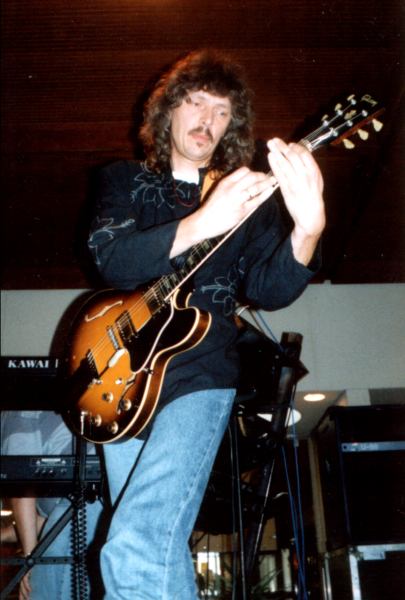

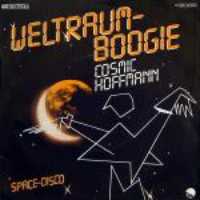 In 1981 I signed a contract with EMI for a single with the dull name “Weltraumboogie”. It was the time of simple synth melodies with danceable rhythms, and my song had it all. I never quite understood why those record company blokes raved so enormously about a song that was pure fun, not to be taken seriously! But they probably scented a big hit in it (which it never became) and gave me a lot of money. Quite an experience but not my path to follow in the future!
In 1981 I signed a contract with EMI for a single with the dull name “Weltraumboogie”. It was the time of simple synth melodies with danceable rhythms, and my song had it all. I never quite understood why those record company blokes raved so enormously about a song that was pure fun, not to be taken seriously! But they probably scented a big hit in it (which it never became) and gave me a lot of money. Quite an experience but not my path to follow in the future!
 Klaus, can you provide a more in-depth description of each Mind over Matter albums that have been released?
Klaus, can you provide a more in-depth description of each Mind over Matter albums that have been released?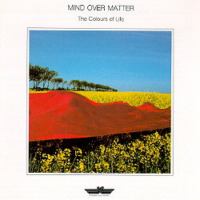 Within only one year I had to create a follow-up record that should become a winner too without simply copying the first one. Oh boy, what a difficult task! At the end of the day I decided to use the impressions (the birth of my son Tim) I was under then as a platform for my new songs and it perfectly worked. Songs like “Bali Sunrise” and “Ganga” have become MOM trademarks and helped to sell the album more than 16.000 times.
Within only one year I had to create a follow-up record that should become a winner too without simply copying the first one. Oh boy, what a difficult task! At the end of the day I decided to use the impressions (the birth of my son Tim) I was under then as a platform for my new songs and it perfectly worked. Songs like “Bali Sunrise” and “Ganga” have become MOM trademarks and helped to sell the album more than 16.000 times.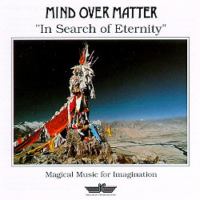 with its exceeding “Journey to Eternity”’ and “‘Pilgrims of Eternity” came out, reflecting the Buddhist influence I was under at that time. “Palace of the Winds” followed in 1995 and won a lot of international prizes. Especially its tremendous “Shangri-La” deeply impressed the critics and the listeners. The corresponding stage shows with sabre dances, flags and a belly dancer helped to make MOM even more known.
with its exceeding “Journey to Eternity”’ and “‘Pilgrims of Eternity” came out, reflecting the Buddhist influence I was under at that time. “Palace of the Winds” followed in 1995 and won a lot of international prizes. Especially its tremendous “Shangri-La” deeply impressed the critics and the listeners. The corresponding stage shows with sabre dances, flags and a belly dancer helped to make MOM even more known.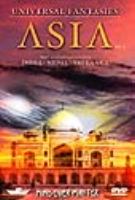 Starting again with the new owner, IC published two dvd’s (“Asia Vol.1” and “Asia Vol.2”) with sonically improved versions (Dolby 5.1) of my best songs along with footage from my travelling and a rare live video of the MOM Live-band.
Starting again with the new owner, IC published two dvd’s (“Asia Vol.1” and “Asia Vol.2”) with sonically improved versions (Dolby 5.1) of my best songs along with footage from my travelling and a rare live video of the MOM Live-band.